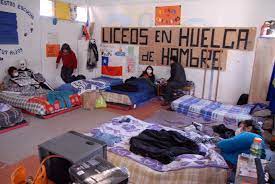
Hunger strikers at a secondary school in Buin, near Santiago.
For two days this week, the streets of Chile filled with indignation … and indignados. These protests are the latest event in a movement that began over three months ago, with a scattered series of classroom boycotts and protests. Since then, students from secondary and tertiary institutions have led teachers and professors, parents and custodians, trade unionists and government workers in protest, in action, in song and dance, in hunger strike, in organizing. The State has responded by arresting 14,000. Already one 16-year-old has been shot and killed. And now, after waves of protest, after State-sponsored bloodshed and belligerence, the State claims it wants a dialogue.
The students began their protests to challenge and change the inequalities within the educational systems and structures, inequalities that are funded, or better de-funded, by mass privatization, on one hand, and a tax structure that sends relatively little money into the schools. Most students attend grossly underfunded public universities while the wealthy few attend the very few exclusive and exclusionary private universities. At present, Chilean university education is one of the most expensive in the world. Students assume extraordinarily high debts, with 50% of them considered heavily indebted. The schools are both expensive and lousy.
As inequality has grown in Chile, so has segregation. According to some, Chile is the second most socially segregated country in the world. The rich study – and play and live — only with the rich, the poor with the poor.
Students began to see the inequality gap as well as the increasing barriers and increasingly high walls as the State condemning them to a slow death sentence. Rather than roll over, they responded with outrage.
Women and girls lead the student movement. 23-year-old Camila Vallejo, for example, is the president of the University of Chile’s student union and the principal spokesperson for the Confederation of Chilean University Students. 18-year-old Francia Gárate is on hunger strike. So are 17-year-olds Johanna Choapa and Maura Roque. María José Zúñiga is spokeswoman for secondary school students at Liceo A-131, high school in Buin next to the capital, Santiago. Pictures and articles show innumerable unnamed women and girls on the front lines, at the bullhorns, on the various stages, in the hunger strikes.
Why are women leading the charge? For almost four decades, Chile has “manufactured modernity” by relentlessly pursuing a neoliberal economic policy: privatization, free trade, the works. And who “bears the brunt” and who literally does “the dirty work of neoliberalism” in Chile? Women. Who looks at the promises of an `emerging’ first world national economy and sees that the money goes for teargas canisters rather than books, for corporate palaces and hotels rather than classrooms? Who looks at the gap and sees who’s making those decisions? Women.
Indignant, insightful women and girls are igniting the Chilean Winter with their outrage.
(Photo Credit: Fernando Fiedler / IPS)